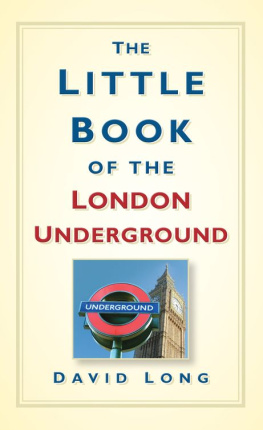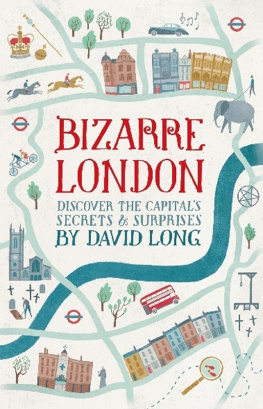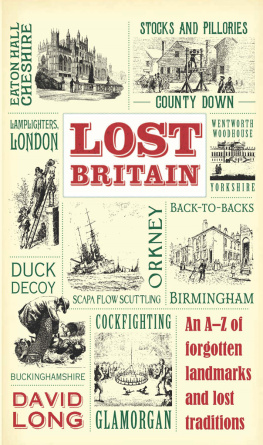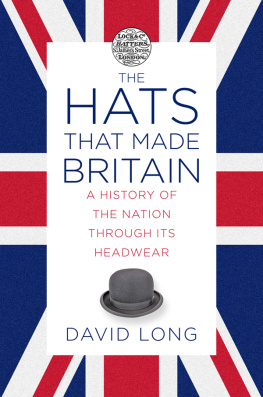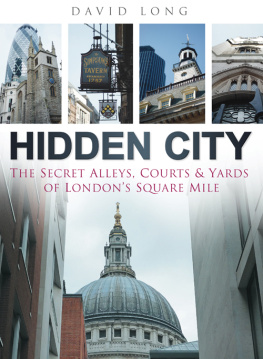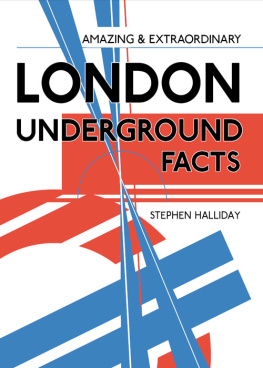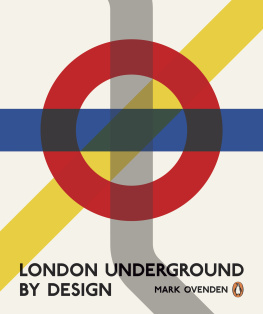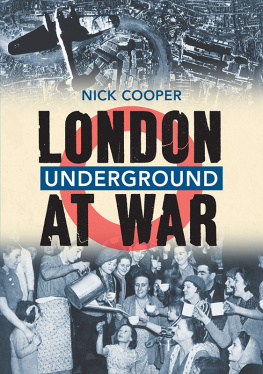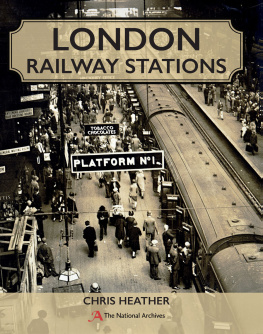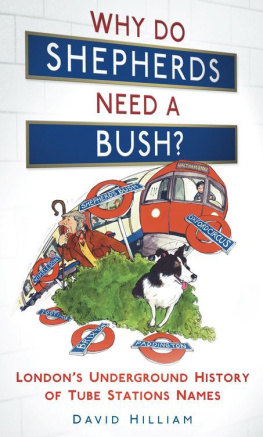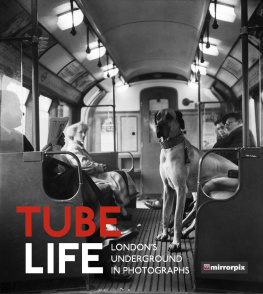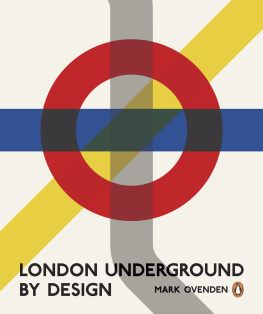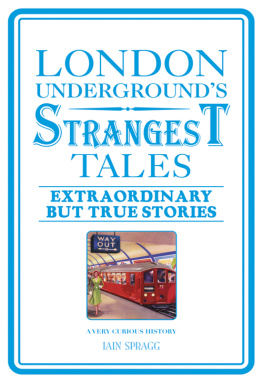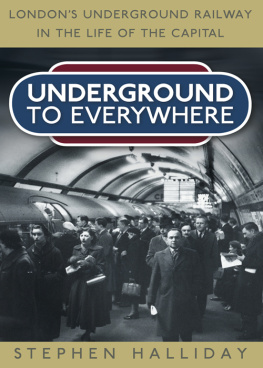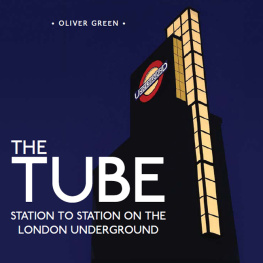A ccording to data obtained under the Freedom of Information Act, the average commuter on the Metropolitan Line every year wastes three days, 10 hours and 25 minutes due to delays.
B ank station in the early days had its ticket office in the crypt of St Mary Woolnoth, a distinguished Nicholas Hawksmoor church.
C entral Line trains make the longest journey on the network, even without the old EppingOngar line, at 34 miles from one end to end the other.
D own Street, one of more than forty disused or ghost stations, is the final resting place of Winston Churchills wartime bath.
E uston station tested an air-freshener called Madeleine on 23 March 2001. Designed to make the Underground smell nice, it was discontinued the day afterwards when passengers complained about feeling sick.
F leet Line was renamed before it even opened: changing the name to the Jubilee is said to have cost 50,000.
G reenfords escalators are unique in that they take passengers up to the trains instead of down to them.
H ounslow East to Heathrow is the only stretch of track where anyone wishing to travel only through half a dozen stations beginning with the letter H can do so.
I n 1890 passengers were liable for a fine of 2 if they travelled on the roof of an underground train.
J ubilee Line trains are the only ones whose route intersects all the other lines.
K ings Cross takes its name from an unpopular monument to George IV, removed in 1845 after being described as a ridiculous octagonal structure crowned by an absurd statue.
L eicester Square to Covent Garden is the shortest distance between two Tube stations.
M ansion House and South Ealing are the only station names in which all five vowels appear.
N orth End station, also known as Bull & Bush, closed for good before a single passenger had ever used it.
O val is named after the famous cricket ground, the shape of which was dictated by the layout of the surrounding housing estate rather than the other way round.
P iccadilly Line warnings to Mind the Gap are voiced by the 12th Earl of Portland, otherwise known as actor Timothy Bentinck who plays David Archer in the famous radio soap.
Q ueen Elizabeth II took her first ride on the Tube as a teenager in 1939.
R oyal Oak, Elephant & Castle, Manor House, Swiss Cottage and Angel stations are all named after public houses.
S t Johns Wood is the only Tube station name on the entire network which uses none of the letters present in the word mackerel.
T emple is the only station name to be shared by the London Underground and the Paris Mtro. (Similarly both the Norwegian railway and the Underground had a station called Strand, although both of these have since closed.)
U nderground trains have only twice been used to transport deceased people in coffins: William Gladstone and Dr Barnardo.
V ictoria station has a plaque commemorating the arrival of the body of the Unknown Soldier at platform 8 on 10 November 1920 before its interment in Westminster Abbey the following day.
W aterloo station used to have a special entrance for corpses being conveyed on the mainline to Brookwood Cemetery in Surrey.
X marks the spot: the deepest part of the Tube network is the Jubilee line at Westminster at 104ft below sea level.
Y ouve probably noticed that the names of Parsons Green, Turnham Green, Redbridge and Stepney Green cleverly describe the colours of the lines on which they appear on the Tube map.
Z oo animals handed into London Transport lost property include three dead bats, a stuffed puffer fish and a dead gorilla.
And, finally, did you know that its possible to travel from Kings Cross to St Pancras to Euston and back again using only northbound trains? This is because the northbound Northern Line runs from Kings Cross to Euston, while the northbound Victoria Line runs the other way. Go figure.
| c. 2000 BC | Oldest known railway a so-called rutway is constructed on island of Malta. |
| 590 BC | A more sophisticated version called the Diolkos uses multi-wheeled trucks or bogies to transport ships across the Isthmus of Corinth in southern Greece. |
| 206 BC | Emperor Shir Huang Di introduces concept of standard axle gauges across the whole of Chinas territories to make transportation more efficient. |
| 1550 | The earliest record of an actual railway, serving a mine at Leberthal in Alsace, although a window in Switzerlands Freibourg Cathedral suggests something similar could have been in existence 200 years earlier. |
| 1798 | Ralph Dodd attempts to tunnel under the Thames, but fails. Marc Isambard Brunel finally manages it forty-five years later by which time the projects been nicknamed the Great Bore but at a cost of ten lives and 614,000. |
| 1801 | The Surrey Iron Railway inaugurates the worlds first public goods railway. |
| 1807 | The Oystermouth or Swansea and Mumbles Railway begins carrying fare-paying passengers, using horse-and even sail-power in the early days. |
| 1829 | George and Robert Stephensons Rocket demonstrates the viability of steam power by winning the 500 Rainhill Trials prize. |
| 1838 | The London & Birmingham Railway into Euston finally brings train services into the capital. |
| 1843 | Charles Pearson, Solicitor to the City of London, proposes alleviating traffic congestion by running a majestic eight-track covered way, thoroughly lighted and ventilated beneath the streets. |
| 1846 | A Royal Commission recommends that no railway should penetrate the area between the Thames and the Euston and Pentonville Roads, thus explaining why most main line terminii lie on what is now the Circle Line. |
| 1855 | Such is the level of traffic congestion in the capital that a committee of MPs is told that, starting out from London Bridge, it takes longer to get to Paddington than to reach Brighton. |
| 1863 | The Metropolitan Railway, Londons first ever underground service, begins running between Paddington and Farringdon. Prime Minister Palmerston elects not to try it himself, declaring that with his eightieth birthday fast approaching he wishes to spend as much time as possible above ground. |
| 1869 | Brunels Thames Tunnel, converted from carriages to pedestrian to rail, is at last used for running trains under the river. Due to reopen in 2010, more than 185 years after work on it began, as the old East London Line it is being transferred to the London Overground network. |
| 1884 | The Circle Line opens and is described in TheTimes as a form of mild torture which no person would undergo if he could conveniently help it. The editor of the Daily Express likens his own trip on it to an experience of Hades but despite this his son goes on to become chairman of London Transport. |
| 1890 | Running 1.25 miles from Stockwell to the Square Mile, the City & South London Line opens as the worlds first electric underground railway. |

